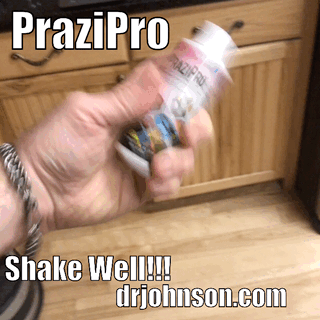“I am a keeper of koi fish and Dr. Johnson has been so helpful to me in understanding koi health and disease. I have been using Praziquantel for a number of years to treat flukes. Recently, a friend forwarded me a comment made on Koiphen saying that Prazi was no longer effective against flukes and that Fluke-M was the new treatment of choice. Does Doc Johnson have an opinion on this? Thanks for any clarification you can bring to this matter!”
The core, active ingredient in Kusuri has been around longer than I’ve been in the hobby, and I started in 1993. It’s spectrum against flukes and intestinal parasites is handsome. Figuring out safe dosing and verifying results enough to come up with a product for the market is worthy of salute.
Here’s Kusuri Fluke-M on its web site at the moment
Here’s a Praziquantel that works every time
Results will change however, when somebody goes to market against Kusuri with a knockoff of the same compound but generic dosing instructions. Then someone will also say “Kusuri doesn’t work anymore.”
That seems to be what’s happening with Praziquantel and I’ll get to that later.
From their sales material:
Kusuri Fluke-M contains 50mg/g Flubendazole based
(Supaverm had Febantel’s “immediate cousin” plus Closantel in it but was lethal to goldfish)
…medication used to eradicate Gill and Body Flukes. This treatment is safe to use without destroying the bacteria in the filter and can be used at any temperature. While dosing with Fluke M you can continue to feed.
This product is designed as a one off treatment, but may require a second dose after 7 days in heavy infestation.
Gill flukes lay eggs and will be harder for any medication to clear because the eggs can’t be killed on the bottom of the pond. So the Praziquantel AND the Kusuri “sometimes” require a subsequent dose to intercept the upcoming egg hatchlings. This is the reason this product says “may require” because if you happen to be dealing with gill flukes, you’ll need to.
For use with all cold water ornamental fish and can be used safely with all tropical freshwater fish.
Kusuri Fluke-M has a four year shelf life from date of manufacture and should be used within three months of opening. Fluke-M can also be used for the eradication of pond snails (##) and Intestinal Helminths Worms.
I would not have guessed it would kill snails. That’s kind of an exciting discovery, as Koi breeders and certain others in the industry consider snails a nuisance, especially in Florida where they’re a vector for certain parasites transmitted by wading birds (Neascus)
For best results use above 15°C. At 10°C a second dose may be required.
Please ensure that you read, understand and follow, all Health and Safety guidelines on the packet.
If the mucus layer is excessive, we advise dosing with Chloramine T at 15g per 1000 gallons, 24 hours before using Fluke M, this will assist in reducing the mucus membrane where body flukes can sometimes get trapped.This is an interesting note – -because Chloramine-T is also a treatment for flukes.
Caution: Please check your pH and KH prior to using. Chloramine T can be very toxic in soft water. If your pH is below pH7 (acid) and has a general hardness below 6°dH (soft water) reduce the dose by 75%. Fluke M is safe to use with salt.
Dosage: 11.8g per 1000 gallons (4546 Litres) of pond water.
For best results use above 15°C.
Directions: Shake contents of the sachet well. Measure out the correct dose for pond, and dissolve in a container with boiling water
I plan to engage some testing on a similar compound called Levamisole on behalf of a Koi breeder, which should have a similar spectrum to Febendazole (sister compounds) and I plan to solublize in ethanol. I wonder if Kusuri would solubilize in ethanol? So much easier. I wonder if the manufacturer tried it?
Stir and allow the mixture to cool before adding slowly to the return of the pond over a 1 hour period. It is recommended that you turn off the UV(##). Fluke-M is safe to use with salt.
This product is designed as a one off treatment, but may require a second dose after 7 days in heavy infestation.
What about Praziquantel not working anymore?
First, people say “always” and “never” and other ‘absolute’ crap like that as if they’re seeing all the cases. It’s ridiculous. Because they might be intelligent, they MEAN: “Praziquantel doesn’t work as much for ME anymore and I’ve treated a LOT of cases and have confirmed in most cases what I’m asserting with my talent with microscopes, [which the average person can’t say either, making them an ass hat.]
Praziquantel

Praziquantel has been produced and provided to the Koi and pond fish industry for an easy 10 years. When it first came out it was tablets from the vet, and impossibly expensive. Then some folks came out with it in a liquid and powder form, and solubilized it a variety of ways. Purity and concentration varies drastically and now, non-business people can buy a kilo of raw “Praziquantel” on line for a reasonable sum.
The purity of that bulk powder is impossible to confirm.
Purity is “probably great” though, but dosing must be carefully done to make sure you’re using ENOUGH and that’s not ‘easy’. If you’re having trouble all-of-a-sudden with “Praziquantel not working” anymore, check your product and dose! Because with PraziPro there’s no problem in my hands. And I’m no genius.
Water conditions and circulation matter as well. If you don’t solubilize the Praziquantel correctly and distribution around the pond is incomplete, and if there’s a lot of organics in the system to hide the Flukes and bind the chemical.
System organics play a role in both medications’ distribution and survival in the water column.
Intercepting eggs which are hatching later is the BIGGEST factor. (Some flukes lay eggs and others give live-birth. Egg layers are harder to eradicate.
Solubility limitations with both Kusuri and Praziquantel is huge
It has become almost common place, for people to buy Praziquantel powder (raw) and attempt to solubilize it and does it correctly which IS NOT EASY. The savings, I suppose are great. But mistakes and inadequacies happen.
A product called PraziPro put together by Hikari has worked around the solubilty issues, and I’ve used it, and confirmed kills in Flukes of both species. The key is the SUBSEQUENT dosing also recommended by Kururi. They’re on the right track with that.

In many instances, in the broader perspective, the whole conversation is moot, because formalin/malachite green are such a good broad-spectrum medication, dosed properly in water of a reasonable temperature and properly aerated, using an expensive single spectrum drug like Praziquantel or Flubendazole is just additional legwork.
In systems of any considerable size, the conversation fails to support the expense of separating single spectrum drugs, because both Praziquantel and Flubendazole would become prohibitively expensive. So, by and large the considerations go to treating flukes specifically, usually best in smaller systems. I would expect properly researched products with a proven track record like PraziPro, to work on par with Kusuri Fluke-M
Someone going in with a homemade version of Kusuri, or a homemade mixture of PraziPro may have different results. And then they’ll pronounce the compound ‘useless‘ in all cases globally.
It is frustrating when someone in the hobby says that “this particular widget doesn’t work anymore”. Especially if it is intended to sell more of another widget. Because parasites don’t suddenly become globally resistant to something just because a couple of people are having trouble or think they’re having trouble dealing with a parasite with one particular medication. But blanket statements are made. It is human nature.
I have talked to a couple of very credible people who double check their results with a microscope and have heard that there are certain strains of flukes, particularly the egg laying ones, that may resist Praziquantel. After talking to a few of these people, we realized that there were consistencies between dosing and water quality as well as the egg-laying (Gyrodactylus) nature of a particular species of flukes that made Praziquantel less effective for those people but more effective for others.
The last five times I’ve treated flukes, I used Clout twice, formalin/malachite on two occasions, and PraziPro from Hikari on the fifth occasion, and got clearance with each and all of those medications respectively.
The Kusuri product utilizes a flubendazole dewormer that could have been expected to be very effective. I am sure that there are individuals who have used it, and then confirmed their kill with microscopes. I would love to believe that individuals who assert that it’s amazing have all confirmed their kills as opposed to the fish just getting better.
There was a similar product called Supaverm they used one of the same ingredients but because of another ingredient (Closantel), it was terminal for Goldfish. Ultimately it faded from view as Praziquantel took over the market. Sometimes would still be nice to have it in case you wanted to get rid of all your goldfish and just keep Koi LOL
I said all that to say this, if you treat with Praziquantel at the proper dose, properly dissolved, in a clean system with a middle of the road alkalinity, making sure to jump back in and treat on day five and/or seven, you’re going to get repeatably remarkable results.
Deviations from the above contribute largely to the reason behind finding flukes 10 to 14 days after you treated with Praziquantel.
I am sure that if you treat with Kusuri according to label instructions, which are admirably specific, using their specific compound, you’re going to get excellent results as well. But the same thing is going to happen to their product as happened to Praziquantel: more people will come to market with that compound, they will use generic dosing, they will be much less specific with dosing instructions, they’ll just push it out there, and it won’t work as well as when you were using a specific product with the specific instructions that went with it.
The hobbyist is encouraged to develop a skepticism of people who say always, and never. I recall when there was a “expert“ walking around that said “Baytril (injection / antibiotic) never works anymore“ and yet, still popping up on sensitivity lists to this day and an excellent drug. Problem is, it doesn’t work in every case, but that doesn’t stop some people from commenting on things like every case is the same..
It’s true, that the more you know about fish health, and fish medicine, the more you realize that you don’t know.




